From the pages of every illustrated book on ancient
Egypt - especially the modern glossy ones - the lotuses and papyri more
or less jump
right into your face. Small wonder: they were among the ancient Egyptian
artist's favorites.
For the time being, we will confine ourselves to depictions of lotus and
papyrus in other uses than as the heraldic plants of Upper and
Lower Egypt.
On the walls of temples and tombs, we see lotus
flowers decorating offerings: wound around earthenware or faience water
vessels, lying on top of piles of food - or as offerings in their own
right.
|
We see ladies at
a banquet, with lotus flowers in their hair, or holding a lotus
flower in their hand, breathing in the wonderful scent. We see
goddesses carrying a staff, crowned with a papyrus flower. In the
catalogue of daily life that covers the inner walls of Old Kingdom
mastabas, papyrus is shown as the raw material from which all
sort of things are made: boats and rafts, rope and paper.
The harvesting of papyrus plants is also depicted:
men are bowed down under heavy loads of gigantic stems. |

The goddess Isis, carrying a papyrus scepter. Hieroglyph C161 from
the Hieroglyphica.
|
Below is part of the vignette of Spell 81A from the Book of the
Dead.
|
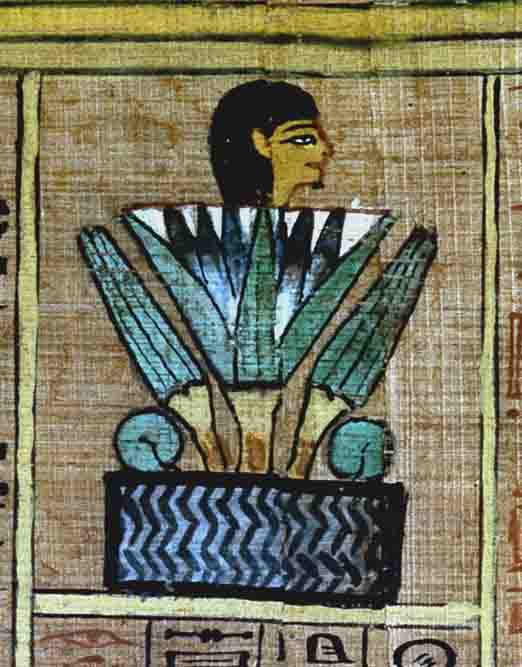 |
It comes from the Book of the Dead
of Any, now in the British Museum. Being one of the finest
surviving manuscripts, it is reproduced frequently.
We see the head of Any, rising from a lotus flower. This image
refers to a myth in which the Sun god is born from a lotus flower.
By inserting his own countenance in this image, Any hopes to share
the fate of the Sun god - and to live forever.
Comparable
depictions of lotus flowers from the same manuscript can be found
in several other vignettes, such as those of Spells 9 and 17.
© Trustees of the
British Museum |
Both the shape of the flower, and the color of its
petals, clearly show this to be the blue lotus.
|
Significant from an iconographic point of view
are the small white triangles between the points of the petals. As
I’ve mentioned before, the ancient Egyptian artist was primarily
focused on working with a shape’s outline. Adjacent, you see the
traditional form for the flower of the blue lotus: |
 |
It is delineated on the top by an arc. When the
artist fills in the drawing with color, he must ignore the top elements,
between the points of the petals, for they do not belong
to the flower itself: they represent empty space. A modern artist would
not have added the arc, thereby letting the space between the points of
the petals stay a part of the background. The Egyptian draftsman however
was committed to the use of simple, yet effective outlines. So he filled
in the surplus space within the outline with white, to indicate that it
was in fact empty space. This makes it a variant of the black that on
statues is used for the space between the two legs, or between the arms
and the torso (what Aldred calls “negative space”: see
Aldred EA).
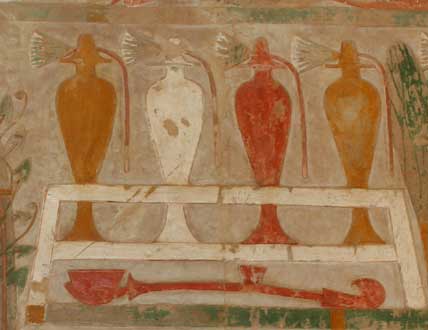
Above is a detail from the Anubis chapel in
Hatshepsut’s mortuary temple at Deir el Bahri. You see a rack with four
water jars, each with a lotus flower on top. Again, the shape of these
flowers is that of the blue lotus. We now recognize the white as
representing the “empty space” within the conventional flower's outline.
The missing blue and green pigments have either faded, or fallen off.
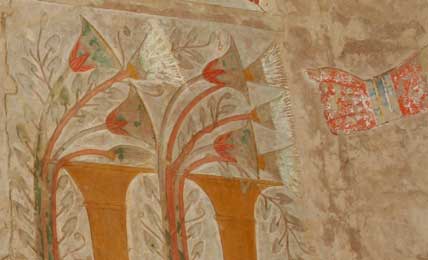
From the same chapel. Here we see papyrus and
lotus flowers themselves as offerings in their own right. The lotus
flowers in this example are of the white variety: note the wider, more
open shape of the chalices. The hand to the right is that of the
recipient: the god Amun-Re.
|
In temples. many columns were shaped as
(bundles of) papyrus stems, crowned with either buds - single or
multiple - or open flowers. Stone columns in lotus-form
were rarely used - and only in private tombs. The first of these
that we are aware of are the two magnificent columns of the
entrance portico of the mastaba of Ptahshepses at Abusir (5th
dynasty). Later on, we find lotus columns occasionally in Middle
Kingdom rock-cut tombs.
The mastaba of
Ptahshepses at Abusir
(5th dyn). © W. de Jong
From "De
Ibis" 2005, page 9. |
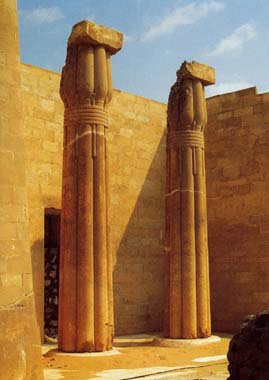 |
Both lotus and papyrus also figured frequently in
the houses of the well-to-do. There, the columns were of wood, and next
to papyrus columns (as well as several other types), we here encounter
quite a few lotiform ones. Both lotus and papyrus flowers also decorated
cosmetic appliances such as wooden spoons for unguents. Handles of
hand-held mirrors often had the shape of a papyrus stem with flower.
The same motifs decorated pieces of furniture, too: see e.g. the wooden
armchair of Hetepheres, mother of king Cheops (4th dynasty).
The sturdy, powerful design of bent papyrus flowers under the arm’s
rests is an echo of the times (StS Art 88).
Likewise, a particularly graceful alabaster lamp in the shape of three
lotus flowers from Tutankhamun’s tomb, reflects the subtlety and
refinement of New Kingdom high court taste. In the Third Intermediate
Period, refined drinking goblets were made of faience, using the shape
of a white lotus (wide, cup-like) or that of a blue lotus (narrow,
beaker-like). (Some very fine specimen of both types in the Myers
Collection, at Eton College.)
|

The white lotus |

The blue lotus |

Papyrus |
Characteristic renderings
of lotus and papyrus in the arts.
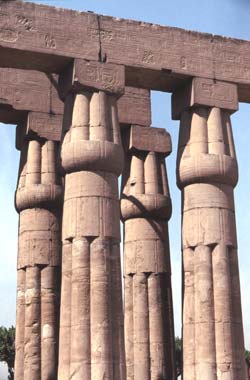 |
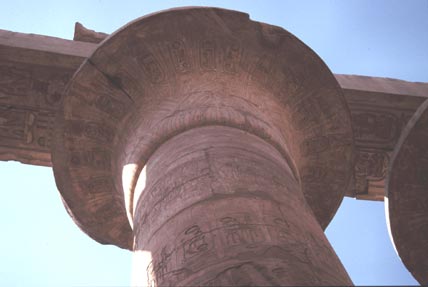
A capital in the shape of an open papyrus flower
(Karnak, the central aisle of the great hypostyle, early 19th
dynasty)
<== Papyrus bundle
columns, with capitals in the form of closed papyrus buds. (Luxor,
court of Amenhotep III, 18th dynasty) |









